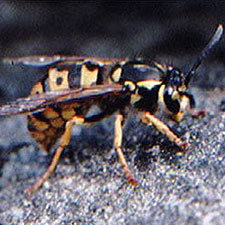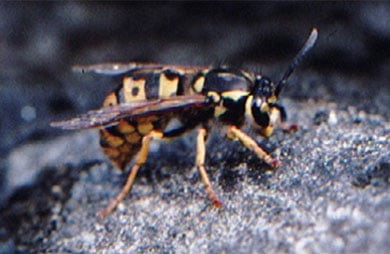 German and common wasps
German and common wasps
Common name: German and common wasp
Botanical name: Vespula germanica (German) and Vespula vulgaris (Common)
Management programme: Advisory
Where are they originally from?
- German wasps are from Europe and North Africa and were first recorded in the 1940s. It has been suggested they were introduced via hibernating queens in crates of aircraft parts returning from World War II.
- Common wasps are native to Europe and parts of Asia. Single specimens were recorded in 1921 and 1945 but it was confirmed as established in the 1970s, though how they were introduced is unclear.
Why are they a pest?
- New Zealand has the highest densities of wasps in the world due to the lack of natural predators.
- Wasps have a detrimental impact on native ecosystems, human health, cause economic losses for bee keepers, and disrupt recreational activities.
- They destroy or seriously damage 8-9% of honeybee hives in New Zealand each year.
- Significantly impact native invertebrate populations.
Where are they found?
- Widespread throughout New Zealand.
- Tend to inhabit agricultural areas, native and exotic forests, scrub and shrubland and urban areas.
- Nest underground and in the cavities of tress and buildings.
What do they look like?
- Size ranges from 12-17mm in length (queens up to 20mm).
- Slightly bigger than a honey bee with smooth rather than hairy bodies.
- Yellow and black stripes with dots on the abdomen.
- Black head and thorax.
- Striped are fused on the common wasp but separated on the German wasp.
What are the rules?
Advisory
Council does not enforce the control of advisory species. It is landowner/occupier responsibility to manage these pests. Council may provide advice on how to manage or control advisory species if required.
How do you get rid of them?
- Insecticide
It is recommended that a nest is sprayed as early as possible in spring and at dusk when all of the wasps have returned to the nest.
CAUTION: When using pesticide please READ THE LABEL thoroughly to ensure that all instructions and safety requirements are followed.
DISCLAIMER: Information in this fact sheet regarding pesticides does not necessarily appear on the labels of the products concerned. Bay of Plenty Regional Council does not accept liability for any damage that may arise from the use of pesticides at non-standard rates. Mention of product trade names implies neither endorsement of those products nor criticism of similar products not mentioned.
Read more on pest control guidelines and regulations

Image credit: DOC
